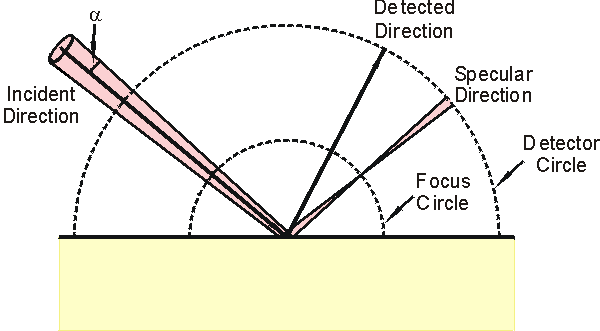class Focussed_Beam_Instrument_BRDF_Model
The class Focussed_Beam_Instrument_BRDF_Model
calculates the effective BRDF averaged for a converging beam incident upon a sample
with a specfied BRDF.
It
accepts as a parameter another BRDF_Model a half angle for the
incident cone and a focal position. Integration is performed
over a right-circular incident code using a multi-point
integration scheme based upon Gauss-Zernike integration.

Parameters:
| Parameter | Data Type | Description | Default |
|---|---|---|---|
| lambda | double | Wavelength of the light
in vacuum [µm]. (Inherited from BRDF_Model.) |
0.532 |
| type | int |
Indicates whether the light is incident from above the
substrate or from within the substrate and whether the
scattering is evaluated in reflection or transmission.
The choices are: 0 : Light is incident from the above the substrate, and scattering is evaluated in reflection. 1 : Light is incident from the above the substrate, and scattering is evaluated in transmission. 2 : Light is incident from the within the substrate, and scattering is evaluated in reflection. 3 : Light is incident from the within the substrate, and scattering is evaluated in transmission. For 1, 2, and 3, the substrate must be non-absorbing. Focussed_Beam_Instrument_BRDF_Model supports any type supported by model. (Inherited from BRDF_Model). |
0 |
| substrate | dielectric_function | The
optical constants of the substrate, expressed as a
complex number (n,k) or, optionally, as a function of
wavelength. (Inherited from BRDF_Model.) |
(4.05,0.05) |
| model | BRDF_Model_Ptr | The light
scattering model. Note: The parameters lambda, type, and substrate must match those of model. |
Microroughness_BRDF_Model |
| alpha | double | The half angle of the incident light cone [deg]. | 0 |
| integralmode | int | The integration order, ranging from 1 to 7. The number of points in the integration depends upon this order and are 1, 4, 7, 16, 21, 36, and 43 for orders 1, 2, 3, 4, 5, 6, and 7, respectively. | 3 |
| focal_point | double | This value is defined as the ratio of the sample-focal-point distance to the sample-detector distance. If the incident light is focussed onto the detector circle, the parameter is 1. If it is focussed at the sample, the parameter is 0. The parameter can take any real value. | 1 |
See also:
SCATMECH Home, Conventions, Instrument_BRDF_Model, dielectric_stack
Include file:
#include "focussedbeam.h"
Source code:
focussedbeam.cpp
Definition of public elements:
class Focussed_Beam_Instrument_BRDF_Model : public Instrument_BRDF_Model { };
For More Information
SCATMECH Technical Information and Questions
Sensor Science Division Home Page
Sensor Science Division Inquiries
Website Comments
Current SCATMECH version: 7.22 (April 2021)